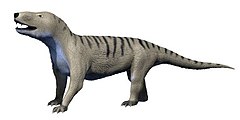| Cynognathus Assemblage Zone | |
|---|---|
| Stratigraphic range: Early-Mid Triassic ~ | |
 Cynognathus crateronotus | |
| Type | Biozone |
| Unit of | Burgersdorp Formation (Beaufort Group) |
| Underlies | Molteno Formation (Stormberg Group) |
| Overlies | Lystrosaurus Assemblage Zone |
| Thickness | up to 1,968.5 feet (600 m) |
| Location | |
| Region | Eastern Cape, Free State |
| Country | |
| Extent | Karoo Basin |
| Type section | |
| Named for | Cynognathus |
| Named by | Harry Govier Seeley (1892) Robert Broom (1906, 1909) |
The Cynognathus Assemblage Zone is a tetrapod biozone utilized in the Karoo Basin of South Africa. It is equivalent to the Burgersdorp Formation, the youngest lithostratigraphic formation in the Beaufort Group, which is part of the fossiliferous and geologically important Karoo Supergroup. The Cynognathus Assemblage Zone is the youngest of the eight biozones found in the Beaufort Group, and is considered to be late Early Triassic (Olenekian) to early Middle Triassic (Anisian) in age (around 247 Ma). The name of the biozone refers to Cynognathus crateronotus, a large and carnivorous cynodont therapsid which occurs throughout the entire biozone.[1]
- ^ Hancox, P.J.; Neveling, J.; Rubidge, B.S. (2020-06-01). "Biostratigraphy of the Cynognathus Assemblage Zone (Beaufort Group, Karoo Supergroup), South Africa". South African Journal of Geology. 123 (2): 217–238. Bibcode:2020SAJG..123..217H. doi:10.25131/sajg.123.0016. ISSN 1012-0750. S2CID 225828531.